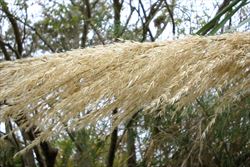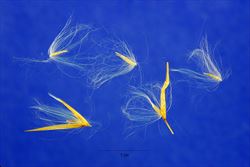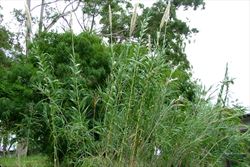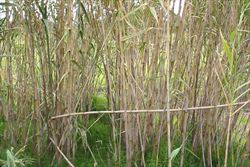Click on images to enlarge

infestation (Photo: Sheldon Navie)

habit on a creek-bank (Photo: Sheldon Navie)

habit growing along a roadside (Photo: Sheldon Navie)

large leaves (Photo: Sheldon Navie)

close-up of stem and leaf bases (Photo: Sheldon Navie)

immature plume-like seed-heads (Photo: Sheldon Navie)

young seed-head (Photo: Sheldon Navie)

close-up of flower spikelets (Photo: Sheldon Navie)

mature seed-head (Photo: Sheldon Navie)

close-up of seeds (Photo: Steve Hurst at USDA PLANTS Database)

variegated leaves of the form sometimes known as Arundo donax var. versicolor (Photo: Sheldon Navie)

leaves and mature seed-heads of Arundo donax var. versicolor (Photo: Sheldon Navie)

infestation along Moggill Creek in Brookfield in Brisbane (Photo: Sheldon Navie)

infestation along the Brisbane River in Indooroopilly in Brisbane (Photo: Sheldon Navie)

habit growing in a suburban park (Photo: Sheldon Navie)

older stems (Photo: Sheldon Navie)

variegated giant reed (Arundo donax 'Versicolor') being cultivated in a garden (Photo: Sheldon Navie)

habit of Arundo donax 'Versicolor' (Photo: Sheldon Navie)

close-up of stem and leaf bases of Arundo donax 'Versicolor' (Photo: Sheldon Navie)

close-up of new leaves of Arundo donax 'Versicolor' (Photo: Sheldon Navie)
Scientific Name
Arundo donax L.
Synonyms
Arundo donax L. var. donaxArundo donax L. var. versicolor (Mill.) StokesArundo versicolor Mill.
Family
Gramineae (South Australia)Poaceae (Queensland, New South Wales, the ACT, Victoria, Tasmania, Western Australia and the Northern Territory)
Common Names
arundo, bamboo, bamboo reed, Danubian reed, elephant grass, false bamboo, giant Danube reed, giant reed, Spanish reed, wild cane
Origin
This species is thought to be native to northern Africa, the Arabian Peninsula, western Asia, Ukraine, the Indian Sub-continent and eastern Asia.
Cultivation
Giant reed (Arundo donax) is widely cultivated as an ornamental grass. A form with variegated leaves (i.e. Arundo donax var. versicolor) is still very common in cultivation, and may also be present in naturalised populations.
Naturalised Distribution
A very widely naturalised species that is most commonly found in and around the major urban centres (e.g. Sydney, Brisbane, Perth and Adelaide). It is also relatively common or scattered in other parts of eastern Queensland, in eastern and southern New South Wales, in south-eastern and eastern South Australia, in northern, western and south-western Western Australia and in some parts of the Northern Territory. Also naturalised on Norfolk Island and Christmas Island, and possibly naturalised in Victoria.
Naturalised overseas in southern Europe, the UK, other parts of Africa, New Zealand, southern USA, Mexico, the Caribbean, South America and on several Pacific islands (i.e. Hawaii, Fiji, French Polynesia, Nauru, New Caledonia, Palau, Western Samoa and Tonga).
Habitat
A weed of waterways, drainage lines, swampy areas, roadsides, wetter disturbed sites, waste areas, old gardens and urban bushland in temperate, sub-tropical and tropical environments. Also occasionally found in wetter locations in semi-arid regions.
Habit
A very large long-lived (i.e. perennial) grass that grows in dense clumps and reaches up to 8 m in height, but is usually less than 6 m tall. It sometimes grows partially submerged in water.
Distinguishing Features
- a very large, reed-like, clump-forming, grass growing up to 8 m tall.
- its robust upright stems arise from short, thick, creeping underground stems.
- its leaves are very large (5-100 cm long and 1-8 cm wide), relatively narrow, and are sometimes variegated.
- its seed-head is a very large plume-like open panicle (30-70 cm long) that is borne at the top of the stems.
- the seed-heads contain numerous flower spikelets (8-15 mm long) bearing long silky hairs.
Stems and Leaves
The large, somewhat woody, aboveground stems (i.e. culms) are clumped and arise from short, thick, creeping underground stems (i.e. rhizomes). These robust stems (up to 4 cm thick) are sparingly branched, hairless (i.e. glabrous) and mostly hollow.
The leaves are usually very large (5-100 cm long and 1-8 cm wide), lance-shaped (i.e. lanceolate) or very elongated (i.e. linear) in shape, and have a pointed tip (i.e. acute apex). These leaves are alternately arranged along the stems and consist of a stem-clasping leaf sheath and a spreading leaf blade. There is a small structure (i.e. ligule) where the leaf sheath meets the leaf blade. It consists of a short membranous flap topped with hairs 1.5-3 mm long (i.e. the ligule is a ciliated membrane).
Flowers and Fruit
The seed-head (i.e. inflorescence) is a very large plume-like open panicle (30-70 cm long) that barely extends beyond the uppermost leaf. This seed-head is much-branched and relatively dense with large numbers of flower spikelets. Young seed-heads are initially light brown or purplish in colour but usually turn whitish or biege in colour as they mature. The numerous feathery flower spikelets (8-15 mm long) are borne on short stalks on the seed-head branches and bear long silky, whitish-coloured, hairs (8-10 mm long). These flower spikelets each have 4 or 5 tiny flowers (i.e. florets) and two bracts (i.e. glumes) as the base. The bracts (i.e. glumes) are brownish or purplish in colour and 11-13 mm long. Flowering occurs mainly from late spring through to early winter.
The flower spikelets break up at maturity (i.e. they disarticulate above the glumes) leaving the bracts (i.e. glumes) remaining on the seed-head. The small (1-2 mm long) oblong 'seeds' (i.e. grains or caryopses) are enclosed in two papery bracts (i.e. the palea and lemma).
Reproduction and Dispersal
This plant reproduces by seed and the clumps also spread slowly via their creeping underground stems (i.e. rhizomes).
Dispersal of this species, particularly rhizome fragments, occurs in dumped garden waste or during the movement of soil. The feathery seeds may be spread by wind movement and float on water, and rhizomes fragments can also be dispersed downstream during floods.
Environmental Impact
Giant reed (Arundo donax) is regarded as an environmental weed in New South Wales, Queensland, Victoria, South Australia and Western Australia and was recently listed as a priority environmental weed in at least one Natural Resource Management region. It is currently of most concern in south-eastern Queensland, where it is ranked among the top 200 most invasive plant species, and in eastern New South Wales (particularly in the North Coast and the wider Sydney and Blue Mountains regions). Giant reed (Arundo donax) usually grows along river banks and roadsides and in moist or wet sites (e.g. in swamps, wetlands, drainage channels and ditches) where it spreads by underground stems (i.e. rhizomes) and forms large dense colonies. These stands out-compete other vegetation and eventually displace native plants and animals.
It is also invasive in the USA, particularly in Florida and California, where it is a problem in riparian areas and along roadsides. In densely infested areas it has replaced native plants along rivers, such as willows and cottonwoods, thereby interfering with water flow and displacing riverside habitat. Colonies of giant reed (Arundo donax) covering hundreds of acres have been recorded. It is highly flammable and can change fire regimes in invaded areas, thereby transforming riparian communities of native plants into solid stands of this species. Because of these impacts, it has been listed in the Global Invasive Species Database and is regarded to be among the top 100 of the world’s worst invasive species.
Other Impacts
The large amounts of vegetation produced by this species can interfere with flood control along waterways, and is a potential fire hazard during the dry season. Populations of this very tall grass have also been responsible of short-circuiting power lines, causing fires.
Legislation
This species is declared under legislation in the following states and territories:
- New South Wales: Class 3 - a regionally controlled weed. The relevant local control authority must be promptly notified of the presence of this weed and it must be fully and continuously suppressed and destroyed (in several local authority areas), and Class 4 - a locally controlled weed. The growth and spread of this species must be controlled according to the measures specified in a management plan published by the local control authority and the plant may not be sold, propagated or knowingly distributed (in several local authority areas). See the New South Wales Department of Primary Industries Noxious Weeds List at http://www.dpi.nsw.gov.au for more detailed information on which local areas are covered in these declarations.
- Western Australia: Unassessed - this species is declared in other states or territories and is prohibited until assessed via a weed risk assessment (throughout the entire state).
Management
For information on the management of this species see the following resources:
- the New South Wales Department of Primary Industries Noxious and Environmental Weed Control Handbook, which can be downloaded from http://www.dpi.nsw.gov.au.
Similar Species
Giant reed (Arundo donax) may be easily confused with common reed (Phragmites australis) and elephant grass (Pennisetum purpureum). These species can be distinguished by the following differences:
- giant reed (Arundo donax ) is a very tall grass (2-7 m tall) with relatively broad leaves (10-80 mm wide). Its much-branched feathery seed-heads (i.e. open panicles) are usually whitish in colour when mature.
- common reed (Phragmites australis ) is a relatively tall grass (1.5-3 m tall) with relatively narrow leaves (10-35 mm wide). Its much-branched feathery seed-heads (i.e. open panicles) are usually light brown when mature.
- elephant grass (Pennisetum purpureum ) is a very tall grass (1-6 m tall) with relatively narrow leaves (20-40 mm wide). Its spike-like bristly seed-heads (i.e. spiciform panicles) are straw-coloured when mature.
Giant reed (Arundo donax) is also quite similar to golden bamboo (Phyllostachys aurea), black bamboo (Phyllostachys nigra), arundinaria reed (Arundinaria simonii forma variegata) and other bamboo species (e.g. Bambusa spp.). However, all these species can be distinguished from giant reed (Arundo donax) by the presence of a strongly constricted lower leaf blade, which resembles a short leaf stalk (i.e. a pseudo-petiole). In contrast, giant reed (Arundo donax) has a relatively broad leaf blade base with a membranous ligule.

